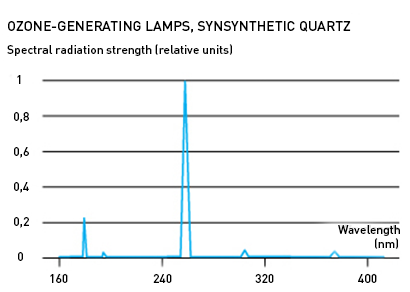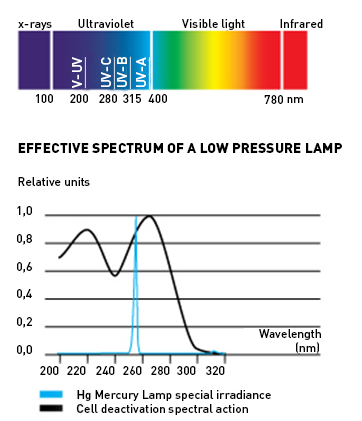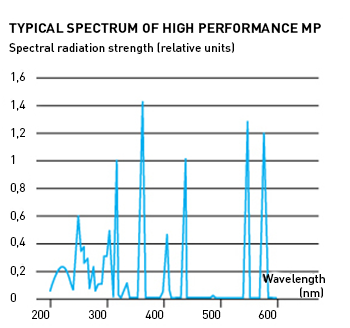
Uv technology
The UV technology is both the oldest and one of the very latest technologies used to disinfect fluids. The method is based on the natural disinfectant action of the sun’s rays. UV lamps imitate the disinfecting rays of the sun. ULTRAAQUA UV systems produce the same ultraviolet germicidal rays, just thousands of times stronger. No bacteria, viruses, moulds or their spores can withstand this treatment.
The reaction time between the UV irradiation and the organism to be killed is very short and does not create any by-products at all. The water quality, both physical and chemical, remains identical before and after treatment using the UV technique. The UV disinfection can therefore take place at any conceivable and necessary place in a system.
true uv performance
UV is a spectrum of light that is just below the visible range to the human eye. The UV-C spectrum (185 – 280 nm) is known as the germicidal spectrum because it is the region that contains the peak germicidal wavelength (260 nm).The UV units for water treatment consist of a specialized low pressure lamp with Mercury indium amalgam filling that produces ultraviolet radiation at 254 nm, very close to the optimum at 260 nm. Compared to the low pressure lamps the medium pressure lamps are poor producers of usable germicidal wavelengths. Medium pressure lamps generally only convert up to 10% of their input watts into usable UV-C watts, whilst amalgam low pressure lamps can be up to 40% efficient. There has been a drastic rise in market share for “low pressure-high intensity” amalgam lamps in the past few years. This has been primarily driven by the need for higher electrically efficient lamps (thus lower electrical operating costs) and the growing awareness in using “green” technologies to reduce carbon footprint.
Low pressure lamps
- Polychromatic spectrum Monochromatic spectrum
- Power density app. 100-500 W/cm Power density app. 0,5-5,5 W/cm
- Power levels 0.5 – 50 kWPower levels 0-800 W
- Efficiency 32-40%
- Lamp life times 8.000-16.000 H
- Lamp surface temperatures 40-120 °C


UV dose and sizing
Sizing of a UV system is affected by three variables:
- Flow rate
- Lamp power
- UV transmittance in the water
The radiation dose is a measure of the biological effect of the UV irradiation. The effect depends on the organism to be killed. The measurement is expressed in mWs/cm² and/or mJ/cm².
Transmission is the capacity of a substance to allow UV light to pass through it, as measured across 1 cm of liquid. When light irradiate the water, the water absorbs part of the radiation. This also means that the disinfectant effect is reduced as the radiation lessens. Disinfection is not the only UV application.
The contact temperature between water and quartz is low and almost no deposits will build up on the sleeve, typically saving customer expenses to a quartz cleaning device. Low pressure lamps generally have a useful life up to 2 years of operation. The electropolished reactors are mere than 30 times more corrosion resistant than a surface that is only passivated [Production Machining, Electropolishing Returns To The Surface, Sep. 2005.]
The UV lamp never contacts the water; it is placed in a quartz sleeve inside the reactor. The lamp is mounted so that water can pass through a flow chamber, and UV rays are admitted and absorbed into the stream.
What UV Dose is Needed?
Coliform bacteria, legionella, faecal bacteria, streptococci, nematodes (eel-worms) and yeasts etc. : 3-40 mWs/cm² (or mJ/cm²)
Pathogenic fungi, such as fusarium, pithium,Phytophtora, etc. : 30-120 mWs/cm² (or mJ/cm²)
Viruses such as cucumber virus, olpidium, cholera, etc. : 60-250 mWs/cm² (or mJ/cm²)
